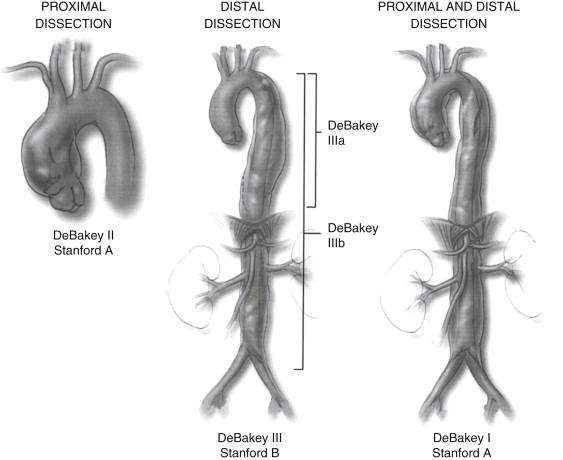Physical Address
304 North Cardinal St.
Dorchester Center, MA 02124
The authors thank Scott A. Weldon, MA, CMI, and Carol P. Larson, BS, AMI, for their outstanding medical illustrations and Stephen N. Palmer, PhD, ELS, and Susan Y. Green, MPH, for invaluable editorial support.
Improvements in anesthesia, surgical techniques, and perioperative care have improved the odds of survival for patients with acute aortic dissection. Additionally, collaborations such as the International Registry of Acute Aortic Dissection (IRAD) have formed to identify factors associated with aortic dissection, as well as to report procedure-specific outcomes. Compared with medical treatment alone, surgical treatment of acute proximal aortic dissection is associated with lower early mortality (24% vs. 59%) and higher 3-year survival (91% vs. 69%). Acute distal aortic dissection generally poses a lower risk of death (13%) because most patients can survive the acute event with medical treatment alone. Patients with life-threatening complications (e.g., impending rupture or malperfusion) need urgent endovascular (see related chapter) or open surgical repair, which IRAD has associated with mortality rates of about 10% and 20%, respectively. The mortality rate associated with surgical repair is generally much lower for chronic distal aortic dissection than for acute dissection and is similar to rates for open aneurysm repair, ranging from 6% to 10% in experienced centers.
Knowing the extent of aorta involved in a dissection is important for determining prognosis and selecting treatments. Traditional anatomic classification schemes include the DeBakey and Stanford systems ( Figure 1 ). Both systems disregard the site of the intimal tear. Dissections are further classified according to the time that has elapsed since the initial tear; a dissection is considered acute within 14 days and chronic after 14 days. Occasionally, the term subacute is used to represent the period between days 15 and 60 after the initial tear. The timing has important implications for surgical decision making, because surgical repair becomes safer as the dissection becomes older and the aorta becomes less fragile. However, this advantage must be weighed against the risk of acute complications, including rupture and malperfusion.

Become a Clinical Tree membership for Full access and enjoy Unlimited articles
If you are a member. Log in here